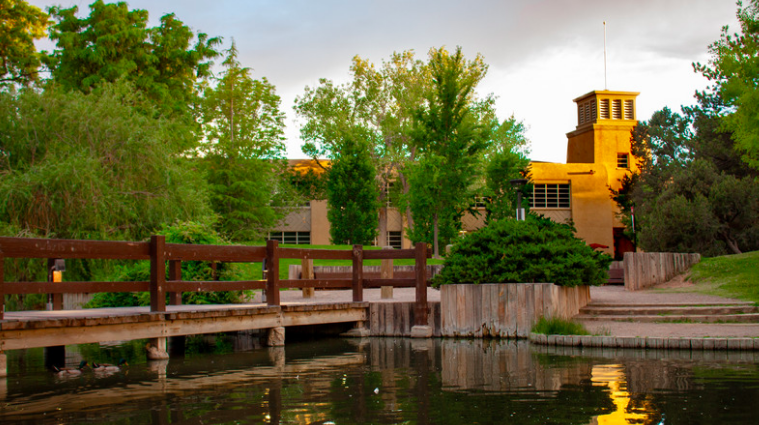
Flag of New Mexico.
Today’s reader question comes from Jay in Flagstaff, Arizona:
Question: After living in Arizona with my mom most of my life, I’ve decided I want to go to New Mexico to college to live in the same state as my dad and my dad’s family. I am interested in history, philosophy, English, and maybe political science. But unlike a lot of guys, what’s really most important to me is beauty – I want to live on a beautiful college campus. I am very creative, and I am inspired when I am surrounded by beautiful things. So, what’s your pick for the most beautiful campus in New Mexico?
Answer: Well, this is an interesting question that I’ve never been asked, but I’ll give it a go by focusing on what I deem to be New Mexico’s best three colleges: New Mexico State University Las Cruces, University of New Mexico in Albuquerque, and St. John’s College in Santa Fe.
New Mexico State University (NMSU) is a land grant university located in Las Cruces, New Mexico. I would describe its campus as beautiful and sprawling. The university has a rich history and offers a wide range of academic programs to its students, so when you are not admiring your surroundings, you have a lot of academic options to choose from.

Las Cruces, New Mexico is home to NMSU.
The campus spans over 700 acres and is filled with lush green lawns, trees, and scenic views of the surrounding mountains. The university has a mix of old and new buildings, with some of the buildings dating back to the early 1900s and others being recently constructed.
One of the most prominent buildings on campus is Corbett Center Student Union, which serves as a hub for student life and activities. The building houses a food court, a student lounge, meeting rooms, and a ballroom, among other facilities.
Another notable building is Milton Hall, which is the oldest building on campus and home to the university’s main administrative offices. The building features beautiful brick architecture and a clock tower that has become an iconic symbol of NMSU.

New Mexico State University’s campus looks good to me.
The university has several residence halls that provide on-campus housing to students, including Garcia Hall, Mohr Hall, and Zuhl Library. The residence halls are equipped with modern amenities and offer a safe and comfortable living environment for students.
The university also has a number of academic buildings, including O’Donnell Hall, which houses the College of Education, and the College of Business, which is located in Paul L. Kirkpatrick Hall. These buildings are equipped with state-of-the-art classrooms, labs, and facilities for students.
The campus also features several athletic facilities, including Aggie Memorial Stadium, the Pan American Center, and the Intramural Field Complex. These facilities are used by the university’s athletic teams and are available for student recreation and fitness.
Overall, the campus of New Mexico State University is a beautiful and well-maintained environment that provides students with all the resources and amenities they need for a successful college experience. A lot of films are also shot in and around Las Cruces because of the region’s natural beauty; therefore, you can experience a pretty environment on and off campus. Learn more about undergraduate admissions to NMSU here.
The University of New Mexico is located in Albuquerque, New Mexico, and encompasses over 600 acres of land in the heart of the city. The campus is known for its distinctive southwestern architecture, including its iconic Hodgin Hall and Zimmerman Library, as well as its lush landscaping, which features lush greenery, colorful flowers, and plenty of open spaces for students to relax and enjoy the beautiful New Mexico weather.
At the center of the campus is the main quad, which is surrounded by many of the university’s key buildings, including the Student Union Building, the Fine Arts Center, and the Mitchell Hall administration building. The quad is a popular gathering place for students, and is often used for outdoor events, such as concerts and festivals.

The Duck Pond on UNM campus.
In addition to its beautiful outdoor spaces, the University of New Mexico is also home to a variety of academic buildings, which house a range of disciplines, including arts and humanities, sciences, engineering, and business. Some of the most notable academic buildings on campus include the Centennial Engineering Center, the Biology Building, and the George Pearl Hall.
The university also has a number of state-of-the-art athletic facilities, including the Dreamstyle Arena, the WisePies Arena, and the Isotopes Park baseball stadium. These facilities are used by both students and members of the community, and are a hub of activity for sports fans and fitness enthusiasts alike.

The view above University of New Mexico.
Overall, the University of New Mexico is a vibrant and dynamic campus, offering a wealth of resources and opportunities for its students, faculty, and staff. Whether you are exploring the beautiful outdoor spaces, participating in one of the many student organizations, or taking advantage of the cutting-edge academic and research facilities, there is something for everyone at UNM. Learn more about undergraduate admissions to UNM here.
Finally, St. John’s College in Santa Fe, New Mexico is a small liberal arts college that is known for its unique curriculum and focus on the Great Books of Western Civilization. Do note that the college has a sister campus in the capital city of Maryland: Annapolis. The Santa Fe campus is actually located on the outskirts of Santa Fe and is surrounded by the stunning natural beauty of the southwestern United States.

St. John’s College Santa Fe Campus
The campus itself is comprised of a number of historic buildings, including the main administration building, which dates back to the early 20th century, and several smaller residential buildings that were built in the Spanish Colonial Revival style. The buildings are set among lush gardens and open spaces, creating a serene and peaceful atmosphere for students and visitors alike.
One of the most distinctive features of St. John’s College is its commitment to a “tutorial” mode of instruction, in which students engage in one-on-one discussions with their professors and participate in small, seminar-style classes. This approach to learning is designed to foster critical thinking and close engagement with the texts, and is a hallmark of the St. John’s College experience. Based on your potential interest in majors, I think this college may really speak to you since its curriculum dives into “The Great Books.”
In addition to its academic facilities, the campus of St. John’s College in Santa Fe also features several student life amenities, including a dining hall, a student lounge, and a library. The library is an important resource for students, and is home to a collection of over 50,000 volumes, including many of the Great Books that form the basis of the college’s curriculum.

Another view of St. John’s College Campus in Santa Fe, New Mexico.
The campus of St. John’s College is also surrounded by the rich cultural heritage of Santa Fe, with its many museums, art galleries, and historic landmarks. The city is known for its vibrant arts scene, and students at St. John’s College have access to a wide range of cultural events and activities, from classical music concerts to contemporary art exhibitions.

Santa Fe, New Mexico is known for some of America’s most distinctive architecture.
Overall, the campus of St. John’s College is a unique and inspiring place, offering a rich educational experience in a setting that is both intellectually stimulating and aesthetically pleasing. Whether you are a student, faculty member, or simply a visitor, you are sure to be impressed by the beauty and charm of this one-of-a-kind college. Learn more about undergraduate admissions to St. John’s College here.
Both of the state universities mentioned above are not only pretty – they are also relatively easy to get into. NMSU accepts roughly 57% of applicants while UNM accepts roughly 65% of applicants. St. John’s accepts a similar percentage of students but attracts a very small sub-set of applicants to begin with; let’s just say it has a far smaller appeal in today’s pre-professionally focused world of higher education. With that said, I love all of these colleges for the right student. While I know you are prioritizing beauty, at some point you may also want to consider cost of attendance and student life outside of the classroom as well. But, drumroll please…Here is my answer to your question: In my opinion, I think St. John’s College has the best campus for you because both the campus itself and its surroundings in Santa Fe are gorgeous. I’d probably rank NMSU second most beautiful campus and UNM third for beauty. Yet, really, they all are pretty easy on the eyes.
And, remember, beauty is in the eye of the beholder! Now that I’ve given my perspective, I strongly encourage you to take a road trip and see these three colleges for yourself, as I always say there is no such thing as a wasted college visit and you would always test drive a car before buying it so you should do the same with college you plan to invest your time and money into for the next four years of your life. Good luck.


 If you know what you want to study in college and want to earn a high quality undergraduate degree without having to take courses you aren’t interested in, it makes a lot of sense head over to merry old England ASAP! Find out the two reasons I am so keen on Americans (and any other students for that matter) earning their degree in England!
If you know what you want to study in college and want to earn a high quality undergraduate degree without having to take courses you aren’t interested in, it makes a lot of sense head over to merry old England ASAP! Find out the two reasons I am so keen on Americans (and any other students for that matter) earning their degree in England!
 This isn’t the week to be a high school student. Statewide assessment is going on across the country, and thanks to social distancing policies, at least some students are taking the ACT on gym bleachers, six feet apart, straddling a wooden plank across their legs and using it as a desk. Among other things, the results of this ACT will be used in some states to decide which students get merit scholarship money.
This isn’t the week to be a high school student. Statewide assessment is going on across the country, and thanks to social distancing policies, at least some students are taking the ACT on gym bleachers, six feet apart, straddling a wooden plank across their legs and using it as a desk. Among other things, the results of this ACT will be used in some states to decide which students get merit scholarship money.
 TH!NKUK is like a massive multi-day virtual college information session, and it will be the largest scale event organized specifically by UK universities for a North American audience this year. TH!NKUK highlights diverse higher education opportunities in England, Wales, and Northern Ireland and will cover everything from how to submit UCAS applications to what it’s like to arrive in the UK as an international student. Best of all, participants will have the chance to engage with International Admissions Officers, academics, current UK university students from North America, and UK university alumni.
TH!NKUK is like a massive multi-day virtual college information session, and it will be the largest scale event organized specifically by UK universities for a North American audience this year. TH!NKUK highlights diverse higher education opportunities in England, Wales, and Northern Ireland and will cover everything from how to submit UCAS applications to what it’s like to arrive in the UK as an international student. Best of all, participants will have the chance to engage with International Admissions Officers, academics, current UK university students from North America, and UK university alumni.